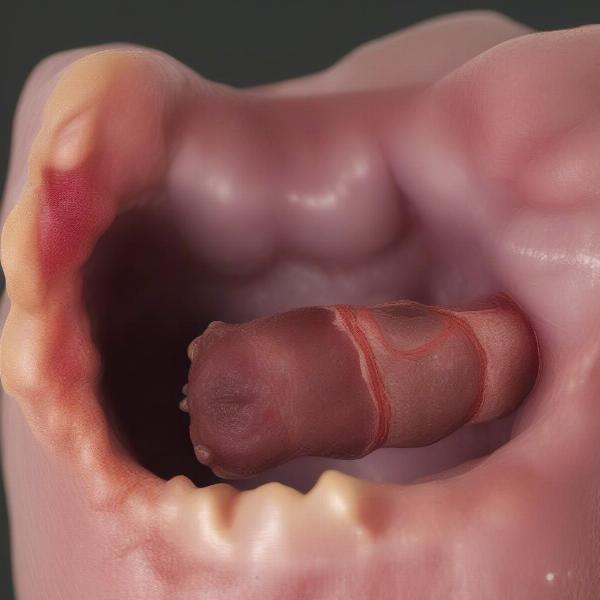Oral cancer in dogs is a serious diagnosis, often leaving owners searching for information and visual aids, like photos, to better understand the disease. This article will provide a comprehensive overview of oral cancer in dogs, including common symptoms, diagnostic processes, treatment options, and what to expect throughout this challenging journey. We’ll also discuss preventative measures and how to provide the best possible care for your furry friend.
Recognizing the Signs: Symptoms of Oral Cancer in Dogs
Oral cancer can manifest in a variety of ways, and early detection is crucial for improving treatment outcomes. Some common signs include persistent bad breath, difficulty eating or swallowing, excessive drooling, facial swelling, bleeding from the mouth, loose teeth, and noticeable lumps or growths within the mouth. If you observe any of these symptoms, it’s essential to consult your veterinarian immediately. While these signs can indicate other less serious conditions, a professional examination is necessary to determine the cause.
Dogs may also exhibit changes in behavior, such as reluctance to play or decreased appetite, which could be indirect indicators of discomfort or pain related to oral cancer. Regularly checking your dog’s mouth can help you become familiar with its normal appearance and make it easier to spot any unusual changes.
Diagnosing Oral Cancer: What to Expect at the Vet
Your veterinarian will perform a thorough physical examination, paying close attention to the mouth, throat, and lymph nodes. They may recommend a biopsy, the definitive way to diagnose oral cancer. This involves taking a small tissue sample and examining it under a microscope to identify cancerous cells. Imaging techniques, such as X-rays or CT scans, may be used to assess the extent of the cancer and determine if it has spread to other areas.
 Advanced Stage Oral Cancer in Dogs
Advanced Stage Oral Cancer in Dogs
Treatment Options and Prognosis
Treatment options for oral cancer in dogs vary depending on the type and stage of cancer, as well as the overall health of the dog. Surgery is often the primary treatment, aiming to remove the cancerous tumor and any affected surrounding tissue. Radiation therapy and chemotherapy may be used in conjunction with surgery or as standalone treatments, especially if the cancer has spread. Palliative care focuses on managing pain and improving the dog’s quality of life.
The prognosis for dogs with oral cancer depends on several factors, including the size and location of the tumor, the extent of spread, and the dog’s response to treatment. Early detection and aggressive treatment significantly improve the chances of a positive outcome.
Prevention and Ongoing Care
While there’s no guaranteed way to prevent oral cancer in dogs, maintaining good oral hygiene can help reduce the risk. Regular brushing, dental chews, and professional dental cleanings can help keep your dog’s mouth healthy and minimize the chances of developing infections or other oral health issues that may contribute to cancer development.
Providing a nutritious diet, regular exercise, and a stress-free environment can also contribute to overall health and potentially lower the risk of cancer. During and after treatment, it’s crucial to follow your veterinarian’s instructions carefully and monitor your dog closely for any signs of discomfort or complications.
Conclusion
Oral cancer in dogs is a challenging disease, but with early detection, appropriate treatment, and loving care, you can help your canine companion navigate this difficult journey. Regular veterinary checkups, a proactive approach to oral hygiene, and a keen awareness of potential symptoms are essential for ensuring the best possible outcome for your furry friend.
FAQs
- What is the most common type of oral cancer in dogs? Melanoma is the most common type of oral cancer in dogs.
- Are certain breeds more prone to oral cancer? Yes, some breeds, such as Cocker Spaniels, German Shepherds, and Poodles, are believed to be at higher risk.
- Is oral cancer in dogs painful? Yes, oral cancer can cause significant pain and discomfort, especially as it progresses.
- Can oral cancer in dogs be cured? While a cure is not always possible, treatment can significantly extend survival time and improve quality of life.
- How can I make my dog comfortable during treatment? Pain medication, soft food, and a supportive environment can help alleviate discomfort during treatment.
- What are the long-term effects of oral cancer treatment in dogs? Long-term effects can vary depending on the treatment and may include changes in eating habits, difficulty swallowing, and potential complications.
- How often should I check my dog’s mouth for signs of oral cancer? It’s recommended to check your dog’s mouth at least once a month.
ILM Dog is a leading international online resource dedicated to providing expert advice and guidance on all aspects of dog care. From breed selection to health and nutrition, training, grooming, and product recommendations, we’re here to support dog owners worldwide. Our expert-driven content covers a wide range of topics to help you make informed decisions and provide the best possible care for your canine companion. For more insights and tailored advice, contact us at [email protected] or call us at +44 20-3965-8624. Visit ILM Dog today!